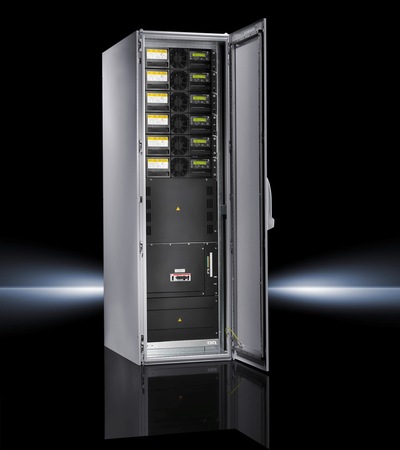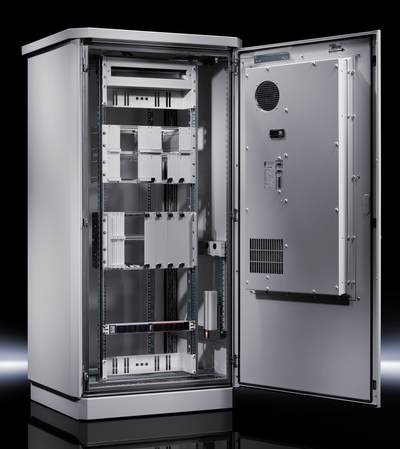Choosing the right UPS technology and system
Thursday, 11 October, 2012
No matter whether a company uses its own data centre or relies on the computing and storage capacity of a cloud computing provider, tough demands are always placed on availability. Therefore, an uninterruptible power supply (UPS) is essential to compensate for fluctuations in the supply voltage and filter out interference. Choosing the right system not only determines the security of the services but also plays a key role in the operating costs.
There is no question that the infrastructure in a data centre has to be protected by a UPS against power failure and malfunctions. The servers, applications and data that make up the digital framework of a company are too important to be left to chance. However, all UPSs are not at all the same. The system that will best suit the requirements depends on a number of factors that have to be evaluated in advance. A risk assessment is by far the most important aspect.
Data centre operators must know their applications inside out and be aware of the effect they have on the operating result. Every company knows how a minute of downtime impacts on operations. According to a survey conducted by PricewaterhouseCoopers, system failures cost at least $15,000 per incident for three-quarters of the companies questioned. 15% of participating companies reported that they had experienced costs in excess of $1.26 million and higher.
UPS systems can usually bridge short power failures lasting up to a few minutes. In this way, they handle well over 90% of all standard failures in the mains supply, which normally last less than two minutes. Longer bridging times require a greater battery capacity and these systems therefore have a bigger footprint. Large or strongly autonomous data centres that have to survive several hours without power are equipped with diesel generators that take over the supply after a specific lead time. Of course, the extra cost of the higher capacity must be justified by the importance of the applications. In some cases, many applications are not business-critical and can be shut down for anywhere between a few minutes and a few hours. The disconnected servers free up capacity, which the UPS uses to ensure a longer bridging time for essential systems.
Modular structure for precise configuration
Earlier UPS systems were extremely large and were previously the only solution and it was not always easy to get the sizing right. These systems were considerably over-designed because it was practically impossible to increase the power at a later date. In principle, system operators had to be prepared to replace the entire UPS with a new, bigger one after the initial system had served its useful life. The superfluous capacity from over-design naturally had a massive impact on procurement costs. From the very first day of operation, customers were paying for potential capacity that they would never actually use. This situation also had a huge impact on the operating costs.
To ensure the necessary redundancy, operators had to operate two identical systems that would both run continuously. The two UPS systems only reached around 50% of their capacity, because one system had to be able to handle the entire load of the other if it were to fail. This reduced the efficiency of the UPS, because systems only achieve optimum performance when they are operated at close to full load. Additionally, the power consumption of the reserve UPS caused double the energy costs.
Today, modular UPS systems solve these historical problems. These modular UPS systems enable step-by-step expansion. Even with very large consumers, the total load is not covered by two identical systems. Instead, modular UPS chassis are equipped with power modules so that, if one module fails, the remaining units will still be able to handle the entire load. System enclosures offer space for multiple power modules in n+1 configuration. There is no single point of failure, because every module has its own controller and its own battery pack. As the modules use a load-sharing concept, every module is backed up at all times and the UPS runs at optimum utilisation with very high efficiency.
In view of rising energy costs, efficiency is more important than ever before. Efficiency is determined to a high degree by the solution’s functional principle and has a significant impact on energy costs. UPS systems without transformers at the output end have the edge in this context. They achieve efficiency levels of 95% and more. Due to the enormous power consumed by a UPS, increasing the efficiency by just 1% can cut annual energy costs by tens of thousands of dollars. And this situation is unlikely to change in the future.
The modular design also makes it easier for operators to scale up. In contrast to traditional systems, users can start with the number of modules they actually need and add more as necessary. Another benefit of this flexible concept is that if one module fails, it can be replaced quickly and easily with another one. A service engineer does not have to be called out and the customer can replace the module if they have another in stock. This minimises the time required to restore the system’s redundancy. And, because system engineers can perform maintenance on the system without interrupting operation or switching to bypass, the criteria of the Tier III and Tier IV specifications of the US Uptime Institute are met at all times.
Capacitive vs inductive loads
Power packs in servers should have a high power factor ideally of 1. To achieve the highest possible factor, power packs use a corrector circuit that causes the power pack to exhibit a capacitive load characteristic from the point of view of the power supplier. With older power packs, the input load’s characteristic tended to be inductive and were designed so they could release their maximum output load inductively. This was an intrinsic consequence of the massive output transformer that was normally used in the UPS. However, if this type of system is equipped with more capacitive terminals, it reaches its power limit far faster than the older installations. By example: If a conventional UPS system with an apparent power of up to 300 kVA is faced with a capacitive load, it provides active power of only 214 kW at a power factor of -0.95. This means that 11% less power is available than expected. Furthermore, a power factor of -0.90 results in active power of just 182 kW.
UPS systems without transformers have a big advantage because they exhibit no power loss and a power factor of up to -0.95 and only 3% at a power factor of -0.90. This means that a smaller UPS can be chosen.
In the past, UPS systems were referred to as online and offline systems and several hybrid concepts were available, too. Today, the IEC standard 62040-3 has put a stop to this muddled terminology. A code following the pattern XXX-YY-123 provides detailed information on the type and properties of the UPS. The first group of letters defines the mode of operation and the second group describes the curve shape of the output voltage. The block of letters at the end defines the limit values for the deviation of the output voltage for various types of failure. VFI represents the toughest requirement, because it demands that the output voltage remains unaffected by fluctuations in the input voltage and frequency. This is equivalent to what would have been known in the past as a double converter or online UPS. These systems offer excellent insulation of input and output, coupled with no changeover time. This means that the connected load is never without power as is inevitably the case with offline systems. As the output voltage is fully controlled, the frequency and voltage waveform can be kept very constant.
Today, VFI is the usual standard for meeting requirements in data centres and server rooms, but some users prefer to rely on less comprehensive backup due to cost reasons. These solutions include Class VI configurations which ensure that the output voltage is not affected by changes in the input voltage, and the output frequency and phase is synchronised with the mains supply. In the old terminology, this was known as single-conversion or line-interactive. Offline-only devices have the abbreviation VFD and they offer the lowest protection of all three methods.
Climate conditions and cooling
Heat dissipation from the modular systems cabinet is also an important consideration. Depending on requirements three versions for air conditioning and cooling are typically available. If ambient air is sufficient for cooling, then perforated sheet steel doors with a 78% open door surface produce a convectional air which has a high enough flow rate to provide effective cooling. Roof ventilators are ideal for use in office environments and they can easily generate heat losses of up to 2000 W from the rack system. Where demands are higher, for example when a rack has been mounted in a high ambient temperature production environment, a cooling unit is required and typically can provide up to 3000 watts of cooling.
These modular compact systems can easily be temperature monitored by a built-in control module and strategically placed sensors. This monitoring provides ageing and performance information as well as early fire warnings, which all serve to increase the system security. In production environments ingress protection is equally important as cooling is. An ingress protection rating of IP54 or higher is a common requirement.
Outlook
Developments in alternative energies are also having an impact on UPS systems. For example, fuel cells are already being used as a source of energy for longer bridging times. Systems currently on offer are suitable for outputs from 2.5 to 40 kW. For higher loads, diesel generators are still the better solution. A RiCell Flex fuel cell system based on hydrogen is currently being tested in numerous pilot projects. It has a modular structure, is environmentally friendly and is emission-free, which means it is quiet and emits no exhaust gases.
In the foreseeable future, UPS systems will become part of the standard equipment for data centres and server rooms. The concept of modularity facilitated by circuit technology eliminated the need for a transformer at the output end. Manufacturers will therefore be able to focus their new design on improving efficiency and so reduce energy costs.
Soft robot uses magnetic fields to power itself autonomously
Inspired by the movement of manta rays, researchers have developed a small, magnetically powered...
Perovskite 'energy sandwich' could power next-gen solar
Researchers have achieved a new level of control over the atomic structure of halide perovskites,...
Creating the truck of tomorrow
Exploring the technological innovations, infrastructure solutions and emerging delivery methods...







